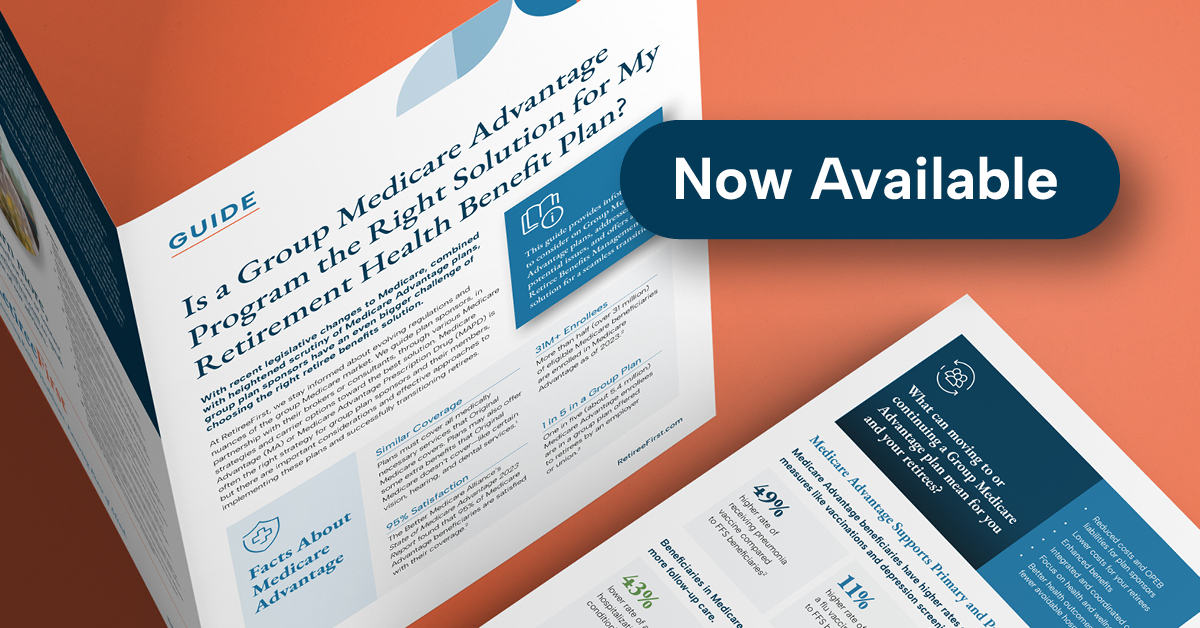
*This article was first published on BenefitsPRO March 19, 2024*
The RDS program has been the go-to choice for plan sponsors who offer group coverage to retired employees, however, the Inflation Reduction Act makes it difficult now for plans to meet the creditable qualification criteria.
The Retiree Drug Subsidy (RDS) is a government-funded program that has historically been the go-to choice for plan sponsors who offer group health care coverage to retired employees. Established under the Medicare Prescription Drug, Improvement, and Modernization Act of 2003 (MMA), its simplicity, limited member impact, and convenience made it a reliable option that financially supported plan sponsors in providing prescription drug benefits to their retiree populations.
However, the health care landscape has changed. Shifts in subsidies, changes within the pharmaceutical industry — such as the growth of biosimilars, gene therapies, and generic drugs — and adjustments to tax structures have diminished RDS’ financial advantages. Furthermore, the impacts of the Inflation Reduction Act of 2022 (IRA) add further incentive for plan sponsors to explore RDS alternatives.
The Inflation Reduction Act, signed into law in August 2022, established a diverse package of health, tax, and climate change measures — including several provisions to reduce Medicare patients’ prescription drug costs and curb federal drug spending. Since RDS plans are commercial drug plans rather than Medicare plans, none of the price-control measures enacted by the IRA apply to them. Consequently, retirees on RDS plans are not benefiting from the reductions in out-of-pocket costs.
Another consideration is that RDS plans must be actuarially equivalent to the Centers for Medicare & Medicaid Services (CMS) basic plan, which includes the member’s out-of-pocket costs. The IRA enhances the CMS Part D basic plan, possibly making it more challenging to qualify for RDS subsidies. Due to IRA changes implemented this year, Medicare Part D beneficiaries with high drug costs won’t pay any cost-sharing once they reach the catastrophic phase of the benefit for their covered Part D drugs. In 2025, the member’s out-of-pocket costs will be $2,000, which will most likely significantly impact creditable coverage qualification for RDS. Part D members also will have the option to spread their Part D out-of-pocket costs over the course of the plan year by making monthly payments, as part of the Medicare Prescription Payment Plan (M3P).
With RDS, CMS reimburses plan sponsors the equivalent of 28% of all allowable retiree drug expenses that fall between the federally designated cost threshold amount and the cost limit, after the removal of actual cost adjustments. This amount is limited per beneficiary, which, like the cost threshold and cost limit, fluctuates from year to year. Because it has been increasing each year, fewer people are landing in the 28% corridor of eligibility. Drug pricing trends have created a unique set of circumstances that make it difficult for prescription expenses to qualify sponsors for RDS reimbursement, as they are either too cheap or too pricey.
Generic drugs are becoming more widespread and affordable, leading to increased usage and lower cost-sharing, which means fewer claims for individuals qualifying for the RDS reimbursement. On the other end of the spectrum, skyrocketing demand for costly specialty medications and new, innovative gene therapies could push other claims for individuals above the 28% subsidy corridor.
Given the significant changes and new regulations affecting the retiree drug subsidy, its utilization is declining. The Medicare Trustees predict that the share of beneficiaries covered through RDS will dip to only 1.5% of Part D enrollment by 2032 – a decline from about 20% in 2010. These developments, and others currently under consideration or awaiting implementation, may profoundly impact retirees’ health costs and benefits.

Impact and Action Needed Based on the CMS Advance Notice
The CMS Advance Notice released on Jan. 31, 2024 (CMS will publish the Final Notice no later than April 1, 2024) brings forth two headwinds for RDS. The first challenge is the shift in the reference plan used to determine RDS creditable coverage qualification. Previously, the reference plan was based on the CMS defined standard prescription drug benefit, assuming no gap coverage. However, starting in 2025, the reference plan will align with the 2025 CMS defined standard prescription drug benefit. This means that prior to 2025, it was easier for RDS plans to qualify as creditable. However, with the significant changes to the Part D benefit in 2025, it will become much more difficult for current RDS plans to meet the creditable qualification criteria. The second challenge is that RDS plans cannot take advantage of the Manufacturer discounts provided under the Discount Program. This means that RDS plans lose the advantage of the manufacturer discounts.
The most important thing an RDS plan can do, and should do now, is to have an actuarial review of their current plan design to determine whether it will remain creditable in 2025. If not, RDS plan sponsors will need to consider benefit changes or even look at moving to a fully insured MAPD or PDP plan. Despite the changes to the prescription drug benefits in 2025, the financials for EGWP Part D plans continue to be more beneficial than RDS since RDS plans do not take advantage of the manufacturer discounts and subsidies.
RDS Alternatives are Available to Plan Sponsors
According to IRA directives, pharmaceutical companies are required to pay rebates if drug prices rise faster than inflation. Price control measures could help hold costs down over the long-term – good news for Medicare Advantage Prescription Drug (MAPD) and Employer Group Waiver Plans (EGWP). Transitioning to one of these plans is one option plan sponsors might consider if they’re looking to shift away from RDS, given the new regulations.
Before taking action, plan sponsors should consider the impact of transitioning their retiree population, which may raise concerns over issues like network changes, prior authorizations, medication coverage, profit gouging by carriers, and overbilling. Such fears are often assuaged by accessing readily available information on the ways CMS exercises strict oversight over Medicare Advantage organizations and their profits. For example, Medicare Advantage revenue must be within 1.5% of the MA organization’s non-Medicare business margin requirement. In addition to monitoring and controlling profits, an annual cap limits beneficiaries’ out-of-pocket costs.
When faced with any type of health care plan changes, enrollees often worry about care delays and denials due to complicated requirements and “red tape”. However, less than half of seniors on Medicare Advantage say they have encountered a prior authorization requirement, and any Medicare-contracted provider can treat a Medicare member. Health care providers who are not contracted with a national PPO MA plan can still receive the health care reimbursements on par with traditional Medicare based on the CMS Physicians Services Schedule.
Reach Out for Help If Needed
The task of researching options and making a choice may seem daunting. However, it can be undertaken by moving through the process one step at a time, starting with a review of your current plan and goals. Benefits advisors who have clients on an RDS plan should review those plans to ensure eligibility and then discuss appropriate options, including the aforementioned possibilities. Conducting an assessment to understand the needs of plan sponsors and retirees is also essential when selecting Medicare products that maximize plan value and reduce costs. Plan sponsors who aren’t already partnered with an advisor or consultant can seek guidance from an actuary or a retiree benefits management provider.
*This article was first published on BenefitsPRO March 19, 2024*






